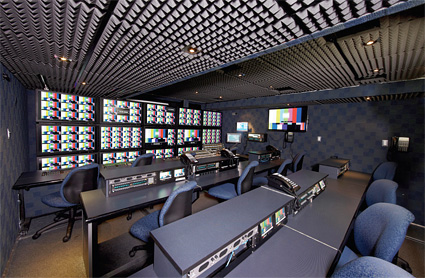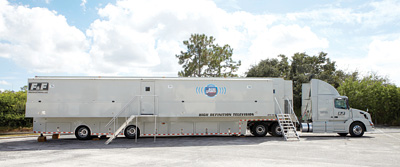GTX-16: Built for the Real World

GTX-16 master control
CLEARWATER, FLA.
Ask F&F Productions’ Sales and Marketing vice president Marc Orgera if the company’s new GTX-16 production truck can shoot in 3D, and he’ll say yes. “You just have to replace the 37-inch monitors inside with 3D-compatible monitors and attach 3D cameras, and you are good to go.”
However, 3D is not what GTX-16 was built for. “The fact is that there just isn’t that much 3D work out there,” Orgera tells TV Technology. “There’s even fewer producers willing to sign a contract to fund and support a 3D production trailer on a regular basis. Even ESPN, which has its own 3D service, has only committed until June 2011 to this format to see if it will pan out or not. So F&F Productions is focusing on what the real world wants—which is HDTV in 2D.”
In taking this position, F&F Productions is not pinching pennies. In fact, the reason GTX-16 can ramp up to 3D production so easily is due to the fact that it is built to be 3D-ready. This is because the truck is built with “3 gig” (3Gbps) networking and routing capabilities. “3 gig has real world applications today for HDTV, which is why it makes sense to add this capability to GTX-16 and other trucks in our fleet,” Orgera says.

The GTX-16 is the fifth in a line of 53-foot expand HD trucks from F&F. Worth noting: The GTX-16 is a complete HDTV audio/video production unit. It does not require a B unit to work with it on site.
FIFTH IN LINE
GTX-16 is the fifth in a line of 53-foot HDTV double expando production trailers operated by F&F Productions. (The other trailers in the series are GTX-11, GTX-12, GTX-14, and GTX-15; no GTX-13.) Although the production technology in each truck has changed as newer models become available, the fundamental layout and wiring design is the same. This is why F&F Productions was able to convert the shell it received from Spevco of Pfafftown, N.C. into a full-fledged production unit in just under a month (July-August 2010).
“In fact, our common production design goes right back to our first truck,” Orgera says. “This is why we know what we’re doing when it comes to outfitting a new trailer, and why we can do it so quickly yet accurately.” This speed allowed the newly-built GTX-16 to shoot the US Open Tennis Championships; as a bonus, the truck worked first for CBS Sports and then ESPN at the event; making GTX-16’s first job a double-header.
FEATURES
GTX-16 GearStorage, Recording & Playout
• EVS HD XT2 Spot Box
• 4 EVS HD XT2+LSM 6 Channel video servers
• 2 EVS HD Xt2+Xfile archive stations, 1 EVS Sport Net2 Hub and IP Director Package.
• 2 Sony SRW-5500 HD VTRs
• Panasonic DVCPRO 1800 HD VTR
• Sony DVW-M2000 Digital Betacam VTR
• 4 DVD-SD Recorder/Players
• 2 DNF Slo Mo controllers
Acquisition
• 12 Ikegami 79EC HD native multi-format CMOS cameras
• 2 Ikegami HDL50 POV cameras, fitted with a range of Fujinon lenses (stabilized, wide angle and handheld)
Audio
• Dolby E system (DP570, DP571, DP572, DP563, DP564 and DM100)
• Yamaha SPX 2000 processor
• 2 Rane audio delays
• 3 DBX 166 XL stereo compressors and two DBX 1046 quadcCompressors
• 2 Digicart/E Ethernet audio recorders with Zip drives
• Evertz 240×240 stereo router (192×192 AES, 48×48 Analog), and a CD player
• Sennheiser Microphones (HMD-25 announcer headsets, ME67MP and MKH 416 shotgun mics; MD 46s, an MKE44P stereo mic and MKH 70 mics), supplemented by warhorse EV 635A handhelds and Sony ECM 77B Lavaliers
Comms
•RTS Adam 128×128 matrix with 16 IFB channels
•15 RTS IFB beltpacks
•30 BP 325 Dual Listen beltpacks Befitting its status as a cutting-edge production unit, GTX-16 is equipped with the latest technology. (It also has lots of interior flexibility, thanks to the movable benches located in its three-tiered production space.)
If GTX-16’s 3G network can be described as its nerves, then the Evertz 288x576 HD router is the truck’s central nervous system. As for a heart? GTX-16 has two. The first covers video; that’s the Grass Valley Kayenne switcher (96 inputs, 48 outputs) with K2 Summit video server (10 hours of HD clip storage). The second heart pumps audio; namely the Calrec Apollo audio console with Bluefin2 that provides up to 1020 channel processing paths.
“The Kayenne is what the networks are specifying when it comes to sports,” Orgera says. “The Apollo offers the expanded audio capacity that our customers are looking for.” (Note: A Chyron HyperX3 character generator and Fingerworks Telestrator can be installed in the GTX-16 upon request.)
An Evertz VIPX Routing and Multi-Image Display System computer-configures the truck’s virtual monitor wall. Made up of 18 37-inch HDTV displays, the screen space on these monitors can be divided and combined as desired. When presets are used, switching from one customer to another is a snap. “For the US Open, we only had five minutes during the handoff from ESPN to CBS Sports,” Orgera says. “Thanks to this truck being built on computer-based configuration, the hot swap was easy. We just went from one set of presets to another.”
GTX-16 has since been on the road covering college football for CBS Sports and it’s expected to be the main production unit for the NCAA Basketball Final Four in Houston in April, also for CBS Sports.
“We actually built this truck for college football, and that’s what it is doing,” says Mark Orgera. “And yes, we built it for 2D. But if a paying 3D opportunity comes up and GTX-16 is available, then we do have the option of switching it over. But again, this kind of job has to make sense in the real world.”
Get the TV Tech Newsletter
The professional video industry's #1 source for news, trends and product and tech information. Sign up below.
James Careless is an award-winning journalist who has written for TV Technology since the 1990s. He has covered HDTV from the days of the six competing HDTV formats that led to the 1993 Grand Alliance, and onwards through ATSC 3.0 and OTT. He also writes for Radio World, along with other publications in aerospace, defense, public safety, streaming media, plus the amusement park industry for something different.

